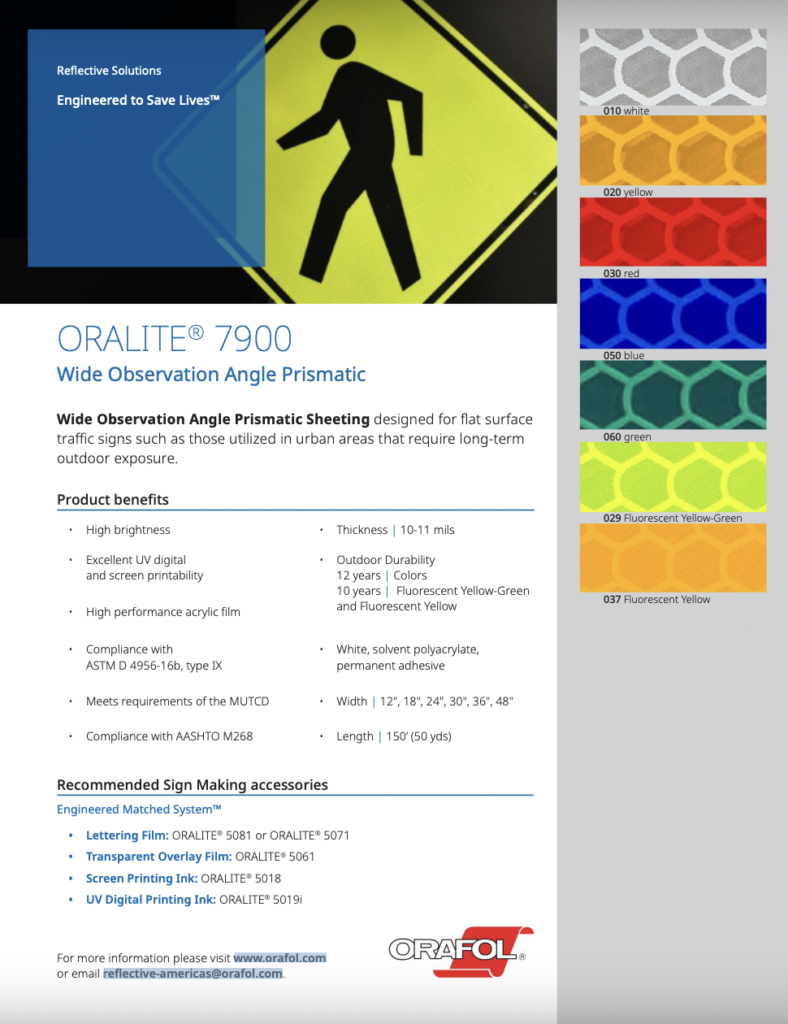Technical data sheets on retro reflective tape often reference the terms “Entrance Angle” and “Observation Angle”. Normally something to the effect of – (Observation Angle : .20 / Entrance Angle : -4) or (Observation Angle – .50 / Entrance Angle : 30), where the observation metric is normally very small, and the entrance metric being much larger. Most readers gloss over these metrics without understanding what they are, or their importance. The purpose of this article is to explain what these two terms mean, and to explain why they are important when it comes to retro reflective sheeting and photo-metrics.
Entrance Angles for Reflective Sheeting
An Entrance Angle is referring to the angle at which a beam of light enters a sheet of retro reflective sheeting. It is calculated with a perpendicular line from the sheeting being “0” degrees. As an example, light entering a sign at a perfect right angle like a T would be a “0” degree entrance angle. From a long distance, the headlights of an automobile would strike a post mounted sign almost perpendicular with a low entrance angle. Then when the vehicle got closer to the sign, and it was off to one side, the angle of entry would increase. As you can see from the diagram below, an entrance angle is measured by the number of degrees from the perpendicular, to the beam of light.

Typical retro reflective sheeting can reflect up to an approximate 60 degree entrance angle from the perpendicular. If the angle is above that, the glass beads or micro prisms in the sheeting begin to be ineffective. To test this, walk around a sign, continuously shining a light on the surface. When your beam is hitting the sign squarely, it will be bright. However, as you get closer to your beam becoming parallel (off to one side) to the reflective sheeting, you will see less return of light and then no reflection. That is due to the entrance angle being too sharp.
Observation Angles for Reflective Sheeting
The Observation Angle is always quoted along with the entrance angle when describing the reflectivity of a sheeting product. It is normally a very small number. It refers to the difference between the entrance angle and the eyes of the person viewing the sign or retro reflective sheeting. So basically it is the difference in angle between the beam of light going from headlights into the film, and the beam of light returning to the eyes of the driver. To be clear, observation angle is NOT measured from the perpendicular. As an example, the observation angle for a person in a sports car would be narrow, however, for a person in a large truck, the observation would be much greater. This is because their eyes are a greater distance from their headlights.
The diagram below shows how observation angles differ in different vehicles. It has everything to do with how far the viewer or drivers eyes are from the headlights of the car or whatever the light source may be. If you look carefully at the diagram, you can see that for trucks, the observation angle is generally much more, which creates a reduction in the amount of returned light they can see. This is because the greater distance is putting their eyes at the outer edge of the cone of reflectivity.

Wider observation angles present a challenge for highway departments of transportation responsible for road signage, because in traffic, every vehicle, both small and large, needs to clearly see signage. Many reflective tape manufacturers, in an effort to offset this issue and keep signage bright at night, have developed wide observation retro reflective sheeting. Oralite 7900 Wide Observation and Oralite 9900 All Observation films are two examples. These reflective tapes are brighter overall, and spread out light a little more so that viewers at greater angles can still see the film. With this technology, the cone of reflectivity is brighter and broader.
So the question is, why don’t all tapes spread out the light like wide observation films. The reason is that for some applications, tapes need to be seen from a very long way away, like in marine environments. For that situation, tapes with tighter observation angles and longer sight distance are used. Oralite M82 FD1403 or 1404 SOLAS tapes would be an example of this. These types of films are generally not used for sign sheeting.

So in summary, the entrance angle is the angle that light strikes the surface of the sign, with zero being the perpendicular or straight on. The observation angle is the angle that the viewers line of sight is from the entrance angle, or beam of car light. The farther the viewers eyes are from the light source, the greater the observation angle. If a person held a light on their nose, the observation angle would effectively be zero.
If you have any questions about reflective tape, and which sheeting is best for your application, use the contact button above to send me a message.